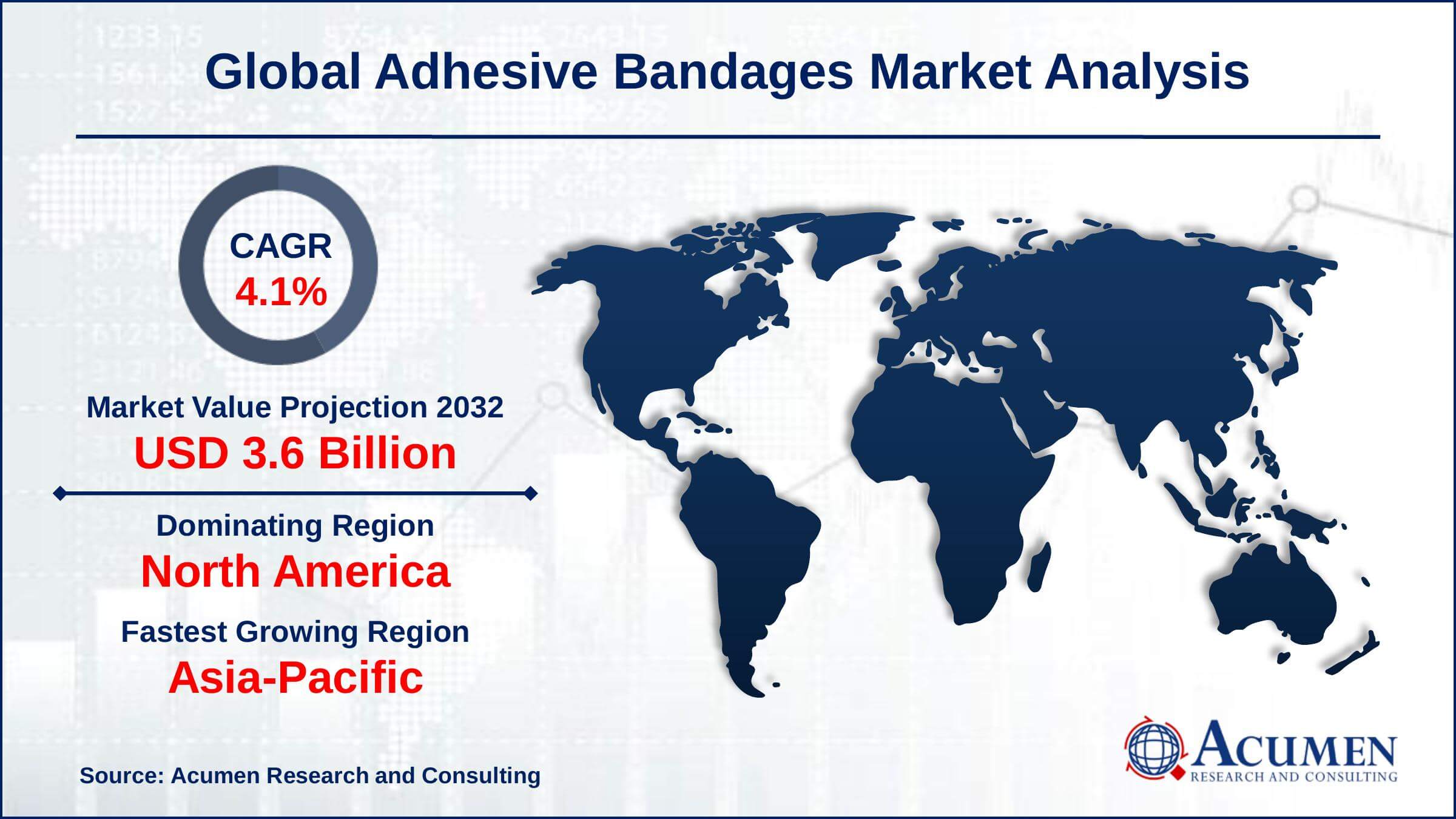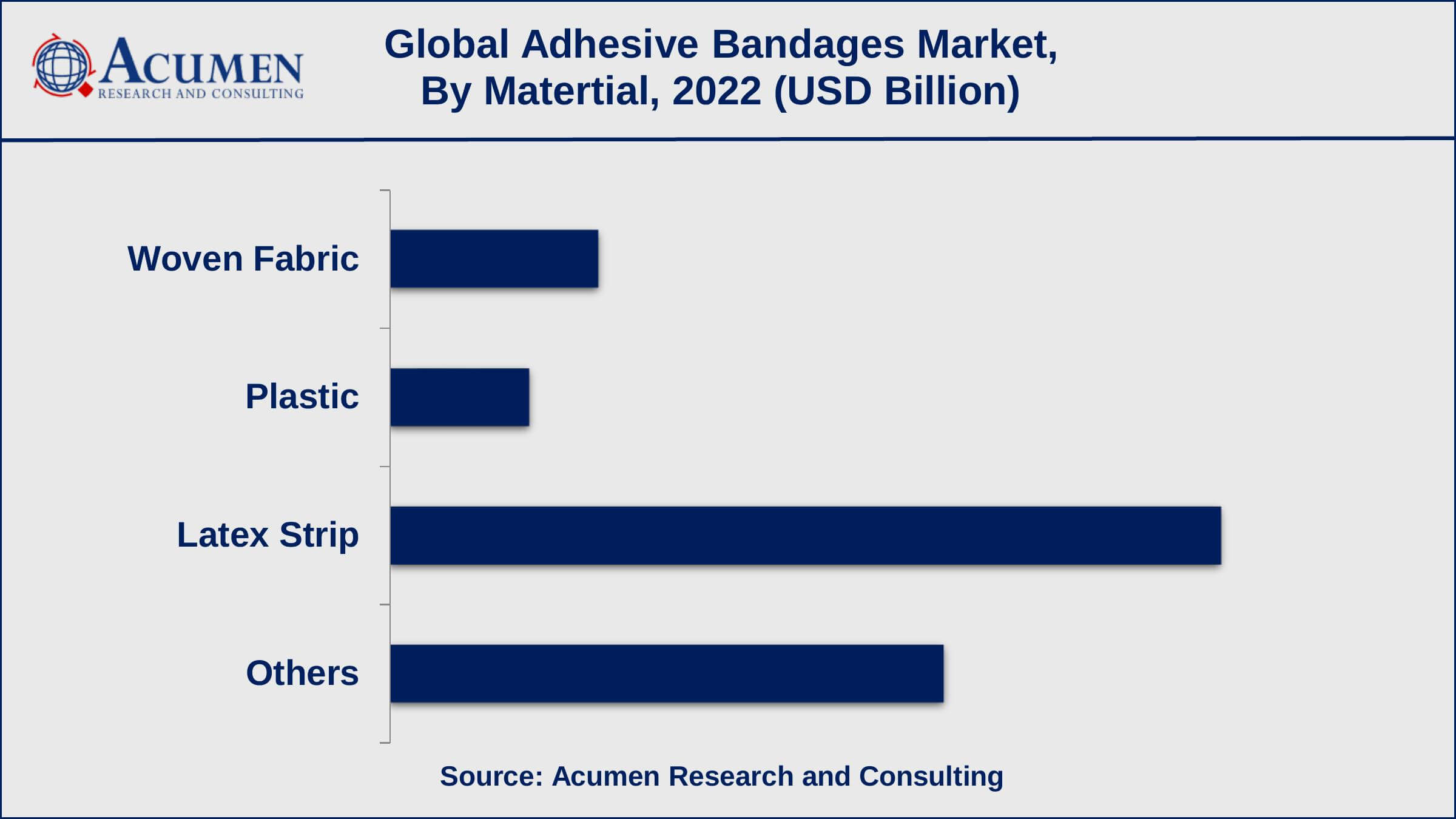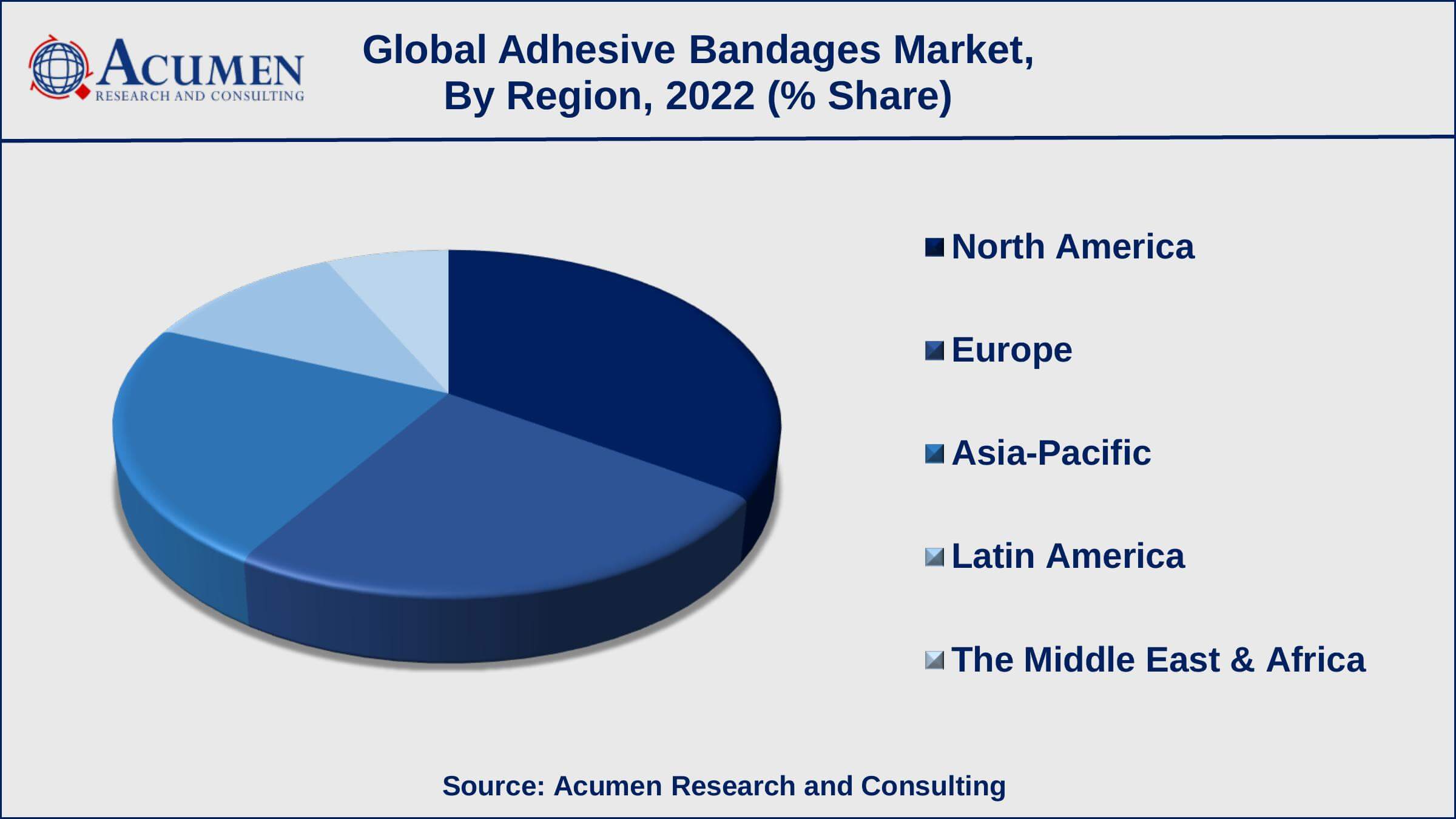Adhesive Bandages Market | Acumen Research and Consulting
Adhesive Bandages Market Size - Global Industry, Share, Analysis, Trends and Forecast 2022 - 2030
Published :
Report ID:
Pages :
Format : 
The Global Adhesive Bandages Market Size collected USD 2.9 Billion in 2022 and is set to achieve a market size of USD 4.1 Billion in 2032 growing at a CAGR of 3.6% from 2023 to 2032.
Adhesive bandages, also known as sticking plaster or just plaster, are small-sized medical dressings used for not-so-serious injuries. Adhesive bandages are also called Band-Aid, especially in the U.S. and Elastoplast in the UK. Adhesive bandages are applied on those injuries which don’t usually require a full-sized bandage and are used by patients who have undergone minor abrasion and have not encountered any serious accident but have cuts or scratches on their bodies. Adhesive bandages help in protecting abrasions or cuts from damage, dirt, dust, fungi, and bacteria and result in the process of quick healing of the injury or wound. Adhesive bandages also help in holding the skin’s cut ends together and thus aid in fastening the healing process.

Adhesive Bandages Market Report Statistics
- Global adhesive bandages market revenue is estimated to reach USD 4.1 billion by 2032 with a CAGR of 3.6% from 2023 to 2032
- North America adhesive bandages market value occupied more than USD 1 billion in 2022
- Asia-Pacific adhesive bandages market growth will register a CAGR of more than 3.5% from 2023 to 2032
- Among material, the latex strip sub-segment generated around 48% share in 2022
- Growth in sport related injuries is a popular adhesive bandages market trend that fuels the industry demand

Global Adhesive Bandages Market Dynamics
Market Drivers
- Rising incidence of cuts and wounds
- Growing awareness about first-aid
- Rising health concerns
Market Restraints
- Availability of alternatives
- Cost of adhesive bandages
- Skin irritation and allergic reactions
Market Opportunities
- Innovation in adhesive bandage technology
- Increase in sports and outdoor activities
Adhesive Bandages Market Report Coverage
| Market | Adhesive Bandages Market |
| Adhesive Bandages Market Size 2022 | USD 2.9 Billion |
| Adhesive Bandages Market Forecast 2032 | USD 4.1 Billion |
| Adhesive Bandages Market CAGR During 2023 - 2032 | 3.6% |
| Adhesive Bandages Market Analysis Period | 2020 - 2032 |
| Adhesive Bandages Market Base Year | 2022 |
| Adhesive Bandages Market Forecast Data | 2023 - 2032 |
| Segments Covered | By Product Type, By Application, By Material, And By Geography |
| Regional Scope | North America, Europe, Asia Pacific, Latin America, and Middle East & Africa |
| Key Companies Profiled | Johnson and Johnson, Medline Industries, Inc., 3M, B. Braun Melsungen AG, Smith & Nephew plc, Kinetic Concepts, Inc., Argentum Medical and ConvaTec, Inc. |
| Report Coverage |
Market Trends, Drivers, Restraints, Competitive Analysis, Player Profiling, Covid-19 Analysis, Regulation Analysis |
Adhesive Bandages Market Growth Factors
An adhesive bandage is made up of woven fabric, plastic, or latex strip and possesses the characteristics of adhesion. A medicated absorbent bandage pad with an antiseptic chemical or Medicated Bandages is present in an adhesive bandage. Various adhesive bandages contain porous and thin polymer coatings on the medicated pad which aids in sticking it to the wound. Adhesive bandages are applied on the wound in such a way that the medicated pad overlaps the wound and the plastic or fabric of the bandage sticks skin surrounding the wound. This is done to restrict the entry of dirt and germs inside the wound. Adhesive bandages are of three types, namely, transdermal patches, special bandages, and butterfly stitches. Transdermal patches are those adhesive bandages that help in delivering medication through the skin and thus do not protect the wound. On the other hand, special bandages are utilized by those patients who remain engaged in food preparation work. Special bandages are blue-colored bandages usually waterproof and have strong adhesive properties that avoid the bandage to loosen up and fall into food. Butterfly stitches are adhesive bandages with thin adhesive strips which are applied to heal small wounds. Adhesive bandages are packed in a sterile and sealed pouch, packet, or bag with the back covered by the sticky side. The sticky cover is removed and a bandage is applied to the wound.
Adhesive bandages come in a variety of shapes and sizes and are used according to the requirement, and size of the wound. The back cover of the bandage is often made of plastic, butter paper, or coated paper. The adhesive part of the bandage is made up of PVC, polyurethane, polyethylene, a woven fabric, or a latex strip. The adhesive used in an adhesive bandage is commonly an acrylate, which includes epoxy acrylate and methacrylate. Whereas, the absorbent pad is made up of cotton with a thin and porous polymer coating, to avoid it from sticking to the injury or wound. In some adhesive bandages, the pad is made up of water-absorbing gel. Such bandages are used in protecting wet wounds as the gel acts like a cushion.
The increasing number of recreational activities, especially for children and teenagers is a key factor driving the growth of the adhesive bandages market. Numerous recreational activities such as cycling, trekking, and others result in abrasions and cuts which require the application of adhesive bandages which, in turn, is augmenting the demand for adhesive bandages. Also, growing incidences of cuts while cooking are expected to further boost the growth of the global adhesive bandages market. Moreover, the aging population is more likely to get cuts or wounds and is a key factor fuelling the overall growth of the global adhesive bandages market. This, in turn, helps in generating the need for adhesive bandages on the wounds, caused due to above-mentioned accident. The availability of different types of adhesive bandages such as special bandages, butterfly stitches, etc. is also anticipated to propel the growth of the global adhesive bandages market. However, increasing allergies among people from latex and polyurethane products is a major factor hampering the growth of the global adhesive bandages market.
Adhesive Bandages Systems Market Segmentation
The worldwide adhesive bandages market is categorized based on product type, applications, material, end-user, and geography.
Adhesive Bandages Market By Product Type
- Medicated Bandages
- Cohesive Fabric Bandages
- Flexible Fixation Bandages
- Non-Medicated Bandages
- Cohesive Fabric Bandages
- Flexible Fixation Bandages
Medicated bandages are becoming increasingly popular in the adhesive bandage industry. Medicated bandages are adhesive bandages that contain medicine to treat cuts and wounds, such as antiseptics or pain relievers. These bandages combine the benefits of a traditional adhesive bandage with the added benefits of medicine to provide a simple and effective solution for the treatment of cuts and wounds. As a result, they have become a popular consumer choice, and they are progressively being used in both the home and healthcare settings.
Adhesive Bandages Market By Application
- Wound Management
- Orthopedic Support
- Pain Management
- Sports and Athletic Wraps
- Other Applications
According to the adhesive bandages market forecast, wound management will have the largest market share from 2023 to 2032. The most common application for adhesive bandages has been wound management. Adhesive bandages are widely used for wound management because they are a quick and easy way to cover cuts and wounds. They are popular among consumers because they help to prevent infection and protect the wound while it heals. While wound management has traditionally been the most popular application for adhesive bandages, other applications such as orthopedic support, pain management, and sports and athletic wraps are also on the rise. The application with the largest market share may differ depending on region, consumer preferences, and product availability.
Adhesive Bandages Market By Material
- Woven Fabric
- Plastic
- Latex Strip
- Others

Latex strip is a widely used material in the manufacture of adhesive bandages, with a sizable market share in the industry. Latex strip is made of natural rubber and is known for its high adhesion and durability, making it an excellent material for adhesive bandages. Furthermore, latex strip is highly flexible and conforms easily to the skin, making it suitable for use on a variety of body parts. It's also resistant to water and other substances, which helps keep the bandage in place and keeps the wound clean. The affordability and widespread availability of latex strip contribute to its popularity in the adhesive bandage market. Latex strip is a popular choice among consumers because it is inexpensive to produce and widely available.
Adhesive Bandages Market By End-User
- Hospitals/Clinics
- Ambulatory Centers
- Other End-Users
In the adhesive bandages industry, hospitals and clinics have the largest market share. Adhesive bandages are commonly used in hospitals and clinics to treat cuts and wounds, provide support to joints and muscles, and manage pain in patients. Because of their convenience, effectiveness, and low cost, adhesive bandages are widely used in hospitals and clinics. They are simple to use and don't necessitate any special training, making them a popular choice among healthcare providers. Furthermore, rising demand for healthcare services, particularly in developing countries, is propelling the adhesive bandages market in hospitals and clinics forward. Hospitals and clinics are expected to play a significant role in the growth of the adhesive bandages market in the coming years as the healthcare industry expands.
Adhesive Bandages Market Regional Outlook
North America
- U.S.
- Canada
Europe
- U.K.
- Germany
- France
- Spain
- Rest of Europe
Asia-Pacific
- India
- Japan
- China
- Australia
- South Korea
- Rest of Asia-Pacific
Latin America
- Brazil
- Mexico
- Rest of Latin America
The Middle East & Africa
- South Africa
- GCC Countries
- Rest of the Middle East & Africa (ME&A)

Adhesive Bandages Market Regional Analysis
The market for adhesive bandages in North America is one of the world's largest and most mature. Factors such as a high incidence of cuts and wounds, a large ageing population, and an increasing demand for sports and athletic wraps drive the market. The United States is the largest market in North America for adhesive bandages, followed by Canada. The region's high demand for adhesive bandages is driven by factors such as rising chronic disease prevalence, an ageing population, and the growing popularity of sports and fitness activities.
The Asia-Pacific adhesive bandage market is one of the world's fastest growing. Factors driving the market include an increase in the incidence of cuts and wounds, an ageing population, and an increase in the demand for sports and athletic wraps. The market is distinguished by the presence of a large and growing population, particularly in China, India, and Indonesia. The rising demand for healthcare services, particularly in developing countries, is also propelling the region's adhesive bandages market forward.
Adhesive Bandages Market Players
Some of the leading adhesive bandages companies include 3M, Argentum Medical, B. Braun Melsungen AG, ConvaTec, Inc., Kinetic Concepts, Inc., Johnson and Johnson, Medline Industries, Inc. and Smith & Nephew plc.
Frequently Asked Questions
What was the market size of the global adhesive bandages in 2022?
The market size of adhesive bandages was USD 2.9 Billion in 2022.
What is the CAGR of the global adhesive bandages market during forecast period of 2023 to 2032?
The CAGR of adhesive bandages market is 3.6% during the analysis period of 2023 to 2032.
Which are the key players operating in the market?
The key players operating in the global market are 3M, Argentum Medical, B. Braun Melsungen AG, ConvaTec, Inc., Kinetic Concepts, Inc., Johnson and Johnson, Medline Industries, Inc. and Smith & Nephew plc.
Which region held the dominating position in the global adhesive bandages market?
North America held the dominating position in adhesive bandages market during the analysis period of 2023 to 2032.
Which region registered the fastest growing CAGR for the forecast period of 2023 to 2032?
Asia-Pacific region exhibited fastest growing CAGR for adhesive bandages market during the analysis period of 2023 to 2032.
What are the current trends and dynamics in the global adhesive bandages market?
The current trends and dynamics in the adhesive bandages industry include rising incidence of cuts and wounds, growing awareness about first-aid, and rising health concerns.
Which product type held the maximum share in 2022?
The medicated bandages product type held the maximum share of the adhesive bandages market.
Select Licence Type
Connect with our sales team
Why Acumen Research And Consulting
100%
Customer Satisfaction
24x7
Availability - we are always there when you need us
200+
Fortune 50 Companies trust Acumen Research and Consulting
80%
of our reports are exclusive and first in the industry
100%
more data and analysis
1000+
reports published till date



